2017 TOYOTA HILUX wheel
[x] Cancel search: wheelPage 47 of 720

471-1. For safe use
1
HILUX_OM_OM0K322E_(EE)
For safety and security
The main SRS airbag system components are shown above. The
SRS airbag system is controlled by the airbag sensor assembly. As
the airbags deploy, a chemical reaction in the inflators quickly fills the
airbags with non-toxic gas to help restrain the motion of the occu-
pants.
WARNING
■ SRS airbag precautions
Observe the following precautions regarding the SRS airbags.
Failure to do so may cause death or serious injury.
● The driver and all passengers in the vehicle must wear their seat belts
properly.
The SRS airbags are supplemental devic es to be used with the seat belts.
● The SRS driver airbag deploys with considerable force, and can cause
death or serious injury especially if the driver is very close to the airbag.
Since the risk zone for the driver’s airbag is the first 50 - 75 mm (2 - 3 in.)
of inflation, placing yourself 250 mm ( 10 in.) from your driver airbag pro-
vides you with a clear margin of safety. This distance is measured from
the center of the steering wheel to your breastbone. If you sit less than
250 mm (10 in.) away now, you can change your driving position in sev-
eral ways:
• Move your seat to the rear as far as you can while still reaching the ped-
als comfortably.
• Slightly recline the back of the seat. Although vehicle designs vary,
many drivers can achieve the 250 mm (10 in.) distance, even with the
driver seat all the way forward, simply by reclining the back of the seat
somewhat. If reclining the back of your seat makes it hard to see the
road, raise yourself by using a firm, non-slippery cushion, or raise the
seat if your vehicle has that feature.
• If your steering wheel is adjustable, tilt it downward. This points the air-
bag toward your chest instead of your head and neck.
The seat should be adjusted as recommended above, while still maintain-
ing control of the foot pedals, steering wheel, and your view of the instru-
ment panel controls.
Page 49 of 720
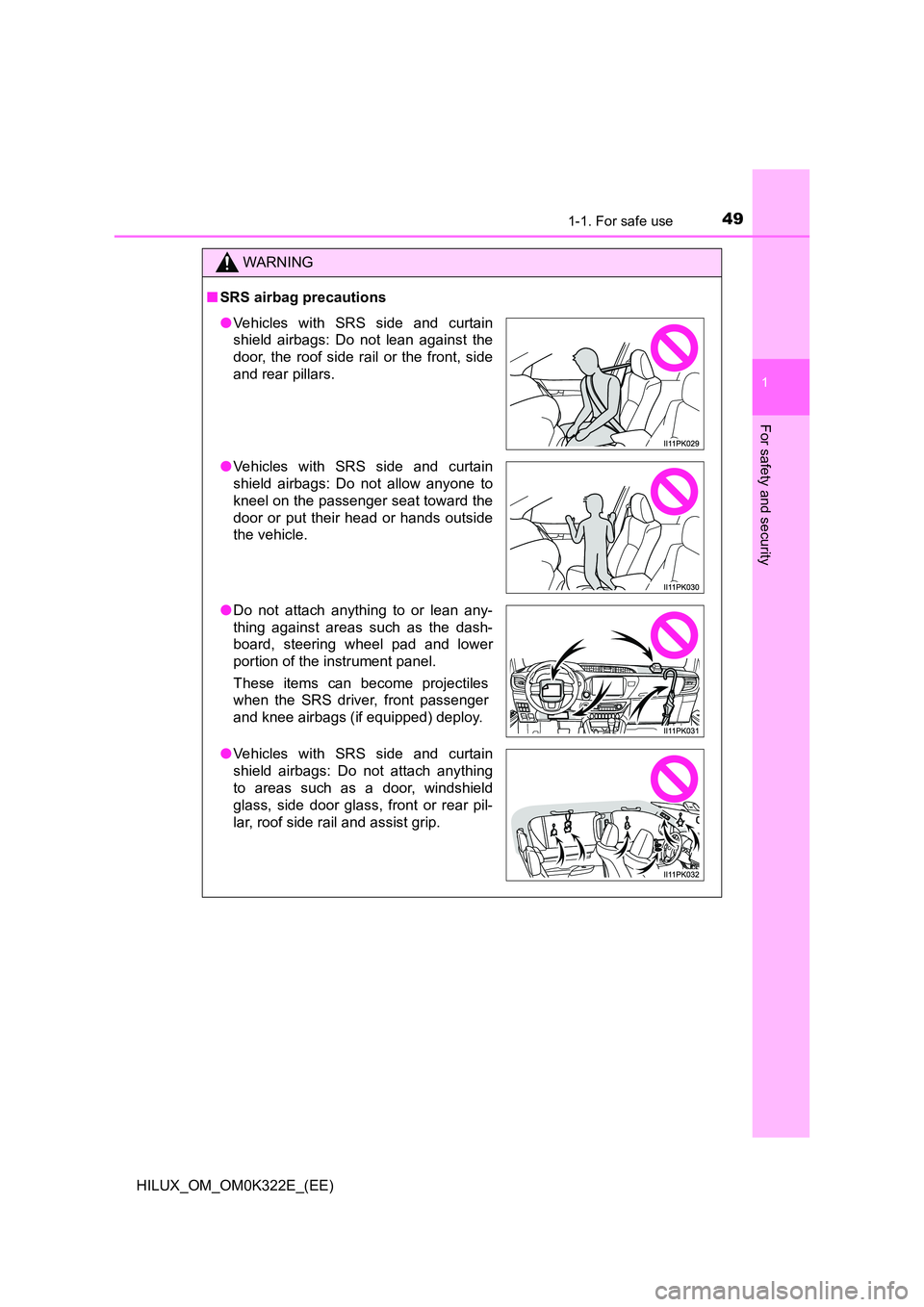
491-1. For safe use
1
HILUX_OM_OM0K322E_(EE)
For safety and security
WARNING
■SRS airbag precautions
●Vehicles with SRS side and curtain
shield airbags: Do not lean against the
door, the roof side rail or the front, side
and rear pillars.
● Vehicles with SRS side and curtain
shield airbags: Do not allow anyone to
kneel on the passenger seat toward the
door or put their head or hands outside
the vehicle.
● Do not attach anything to or lean any-
thing against areas such as the dash-
board, steering wheel pad and lower
portion of the instrument panel.
These items can become projectiles
when the SRS driver, front passenger
and knee airbags (if equipped) deploy.
● Vehicles with SRS side and curtain
shield airbags: Do not attach anything
to areas such as a door, windshield
glass, side door glass, front or rear pil-
lar, roof side rail and assist grip.
Page 50 of 720

501-1. For safe use
HILUX_OM_OM0K322E_(EE)
WARNING
■SRS airbag precautions
● Vehicles with SRS side and curtain shield airbags: Do not hang coat hang-
ers or other hard objects on the coat hooks. All of these items could
become projectiles and may cause death or serious injury, should the SRS
curtain shield airbags deploy.
● Vehicles with SRS driver’s knee airbag: If the vinyl cover is put on the area
where the SRS knee airbag will deploy, be sure to remove it.
● Vehicles with SRS side and curtain shield airbags: Do not use seat acces-
sories which cover the parts where the SRS side airbags inflate as they
may interfere with inflation of the airbags. Such accessories may prevent
the side airbags from activating correctly, disable the system or cause the
side airbags to inflate accidentally, resulting in death or serious injury.
● Do not strike or apply significant levels of force to the area of the SRS air-
bag components.
Doing so can cause the SRS airbags to malfunction.
● Do not touch any of the component parts immediately after the SRS air-
bags have deployed (inflated) as they may be hot.
● If breathing becomes difficult after the SRS airbags have deployed, open a
door or window to allow fresh air in, or leave the vehicle if it is safe to do
so. Wash off any residue as soon as possible to prevent skin irritation.
● Vehicles with SRS side and curtain shield airbags: If the areas where the
SRS airbags are stored, such as the steering wheel pad and front and rear
pillar garnishes, are damaged or cr acked, have them replaced by any
authorized Toyota retailer or Toyota authorized repairer, or any reliable
repairer.
● Vehicles without SRS side and curtain shield airbags: If the areas where
the SRS airbags are stored, such as the steering wheel pad, are damaged
or cracked, have them replaced by any authorized Toyota retailer or
Toyota authorized repairer, or any reliable repairer.
● Vehicles with front passenger occupant classification system: Do not place
anything, such as a cushion, on the front passenger’s seat. Doing so will
disperse the passenger’s weight, which prevents the sensor from detect-
ing the passenger’s weight properly. As a result, the SRS front airbags for
the front passenger may not deploy in the event of a collision.
● Vehicles without smart entry & start sys-
tem: Do not attach any heavy, sharp or
hard objects such as keys or accesso-
ries to the key. The objects may restrict
the SRS knee airbag (if equipped) infla-
tion or be thrust into the driver’s seat
area by the force of the deploying air-
bag, thus causing a danger.
Page 51 of 720
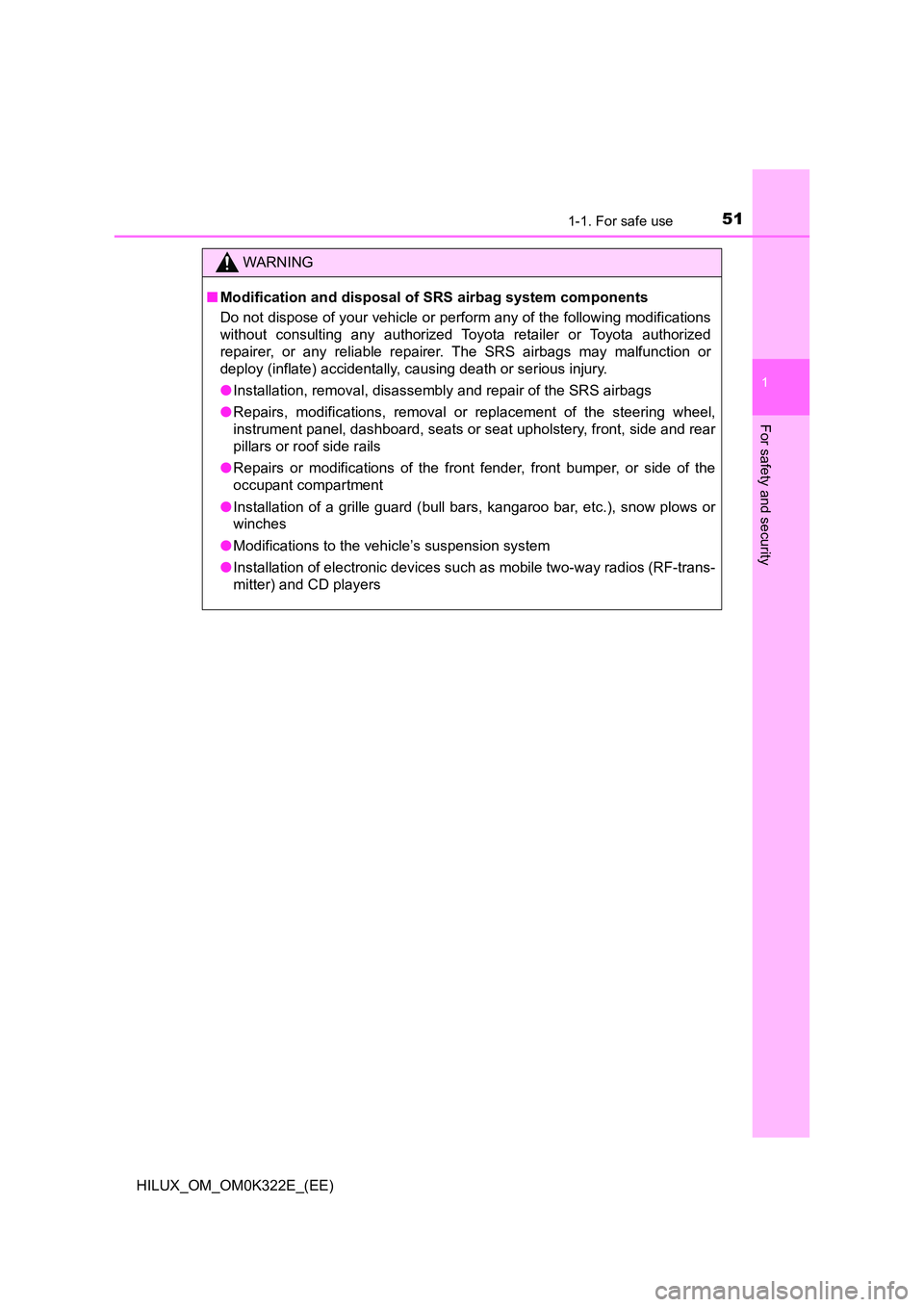
511-1. For safe use
1
HILUX_OM_OM0K322E_(EE)
For safety and security
WARNING
■Modification and disposal of SRS airbag system components
Do not dispose of your vehicle or perform any of the following modifications
without consulting any authorized Toyota retailer or Toyota authorized
repairer, or any reliable repairer. The SRS airbags may malfunction or
deploy (inflate) accidentally, causing death or serious injury.
● Installation, removal, disassembly and repair of the SRS airbags
● Repairs, modifications, removal or replacement of the steering wheel,
instrument panel, dashboard, seats or seat upholstery, front, side and rear
pillars or roof side rails
● Repairs or modifications of the front fender, front bumper, or side of the
occupant compartment
● Installation of a grille guard (bull bars, kangaroo bar, etc.), snow plows or
winches
● Modifications to the vehicle’s suspension system
● Installation of electronic devices such as mobile two-way radios (RF-trans-
mitter) and CD players
Page 52 of 720

521-1. For safe use
HILUX_OM_OM0K322E_(EE)
■If the SRS airbags deploy (inflate)
● Slight abrasions, burns, bruising etc., may be sustained from SRS airbags,
due to the extremely high speed deployment (inflation) by hot gases.
● A loud noise and white powder will be emitted.
● Vehicles without SRS curtain shield airbags: Parts of the airbag module
(steering wheel hub, airbag cover and inflator) as well as the front seats may
be hot for several minutes. The airbag itself may also be hot.
● Vehicles with SRS curtain shield airbags: Parts of the airbag module (steer-
ing wheel hub, airbag cover and inflator) as well as the front seats, parts of
the front and rear pillars, and roof side rails, may be hot for several minutes.
The airbag itself may also be hot.
● The windshield may crack.
● Vehicles with ERA-GLONASS/EVAK: If the SRS airbags deploy, the system
is designed to send an emergency call* to the ERA-GLONASS/EVAK con-
trol center, notifying them of the vehicle’s location (without needing to push
the “SOS” button) and an agent will attempt to speak with the occupants to
ascertain the level of emergency and assistance required. If the occupants
are unable to communicate, the agent automatically treats the call as an
emergency and helps to dispatch the necessary emergency services.
( P. 528)
*: In some cases, the call cannot be made. (P. 531)
■ SRS airbag deployment conditions (SRS front airbags)
● The SRS front airbags will deploy in the event of an impact that exceeds the
set threshold level (the level of force corresponding to an approximately 20 -
30 km/h [12 - 18 mph] frontal collision with a fixed wall that does not move or
deform).
However, this threshold velocity will be considerably higher in the following
situations:
• If the vehicle strikes an object, such as a parked vehicle or sign pole,
which can move or deform on impact
• If the vehicle is involved in an underride collision, such as a collision in
which the front of the vehicle “underrides”, or goes under, the bed of a
truck
● Depending on the type of collision, it is possible that only the seat belt pre-
tensioners will activate.
● Vehicles with front passenger occupant classification system: The SRS front
airbags for the front passenger will not activate if there is no passenger sit-
ting in the front passenger seat. However, the SRS front airbags for the front
passenger may deploy if luggage is put in the seat, even if the seat is unoc-
cupied.
Page 55 of 720
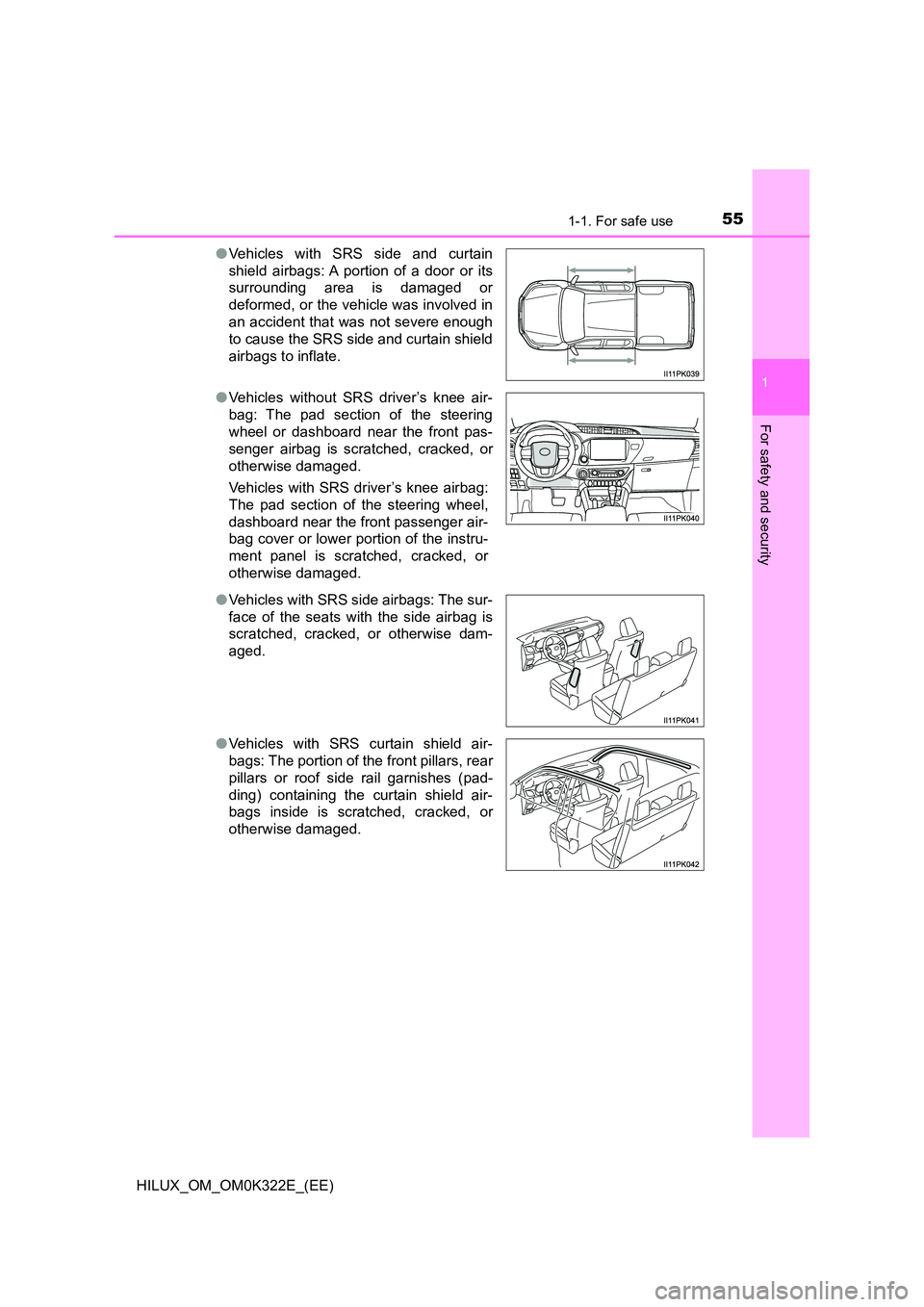
551-1. For safe use
1
HILUX_OM_OM0K322E_(EE)
For safety and security
●Vehicles with SRS side and curtain
shield airbags: A portion of a door or its
surrounding area is damaged or
deformed, or the vehicle was involved in
an accident that was not severe enough
to cause the SRS side and curtain shield
airbags to inflate.
● Vehicles without SRS driver’s knee air-
bag: The pad section of the steering
wheel or dashboard near the front pas-
senger airbag is scratched, cracked, or
otherwise damaged.
Vehicles with SRS driver’s knee airbag:
The pad section of the steering wheel,
dashboard near the front passenger air-
bag cover or lower portion of the instru-
ment panel is scratched, cracked, or
otherwise damaged.
● Vehicles with SRS side airbags: The sur-
face of the seats with the side airbag is
scratched, cracked, or otherwise dam-
aged.
● Vehicles with SRS curtain shield air-
bags: The portion of the front pillars, rear
pillars or roof side rail garnishes (pad-
ding) containing the curtain shield air-
bags inside is scratched, cracked, or
otherwise damaged.
Page 126 of 720
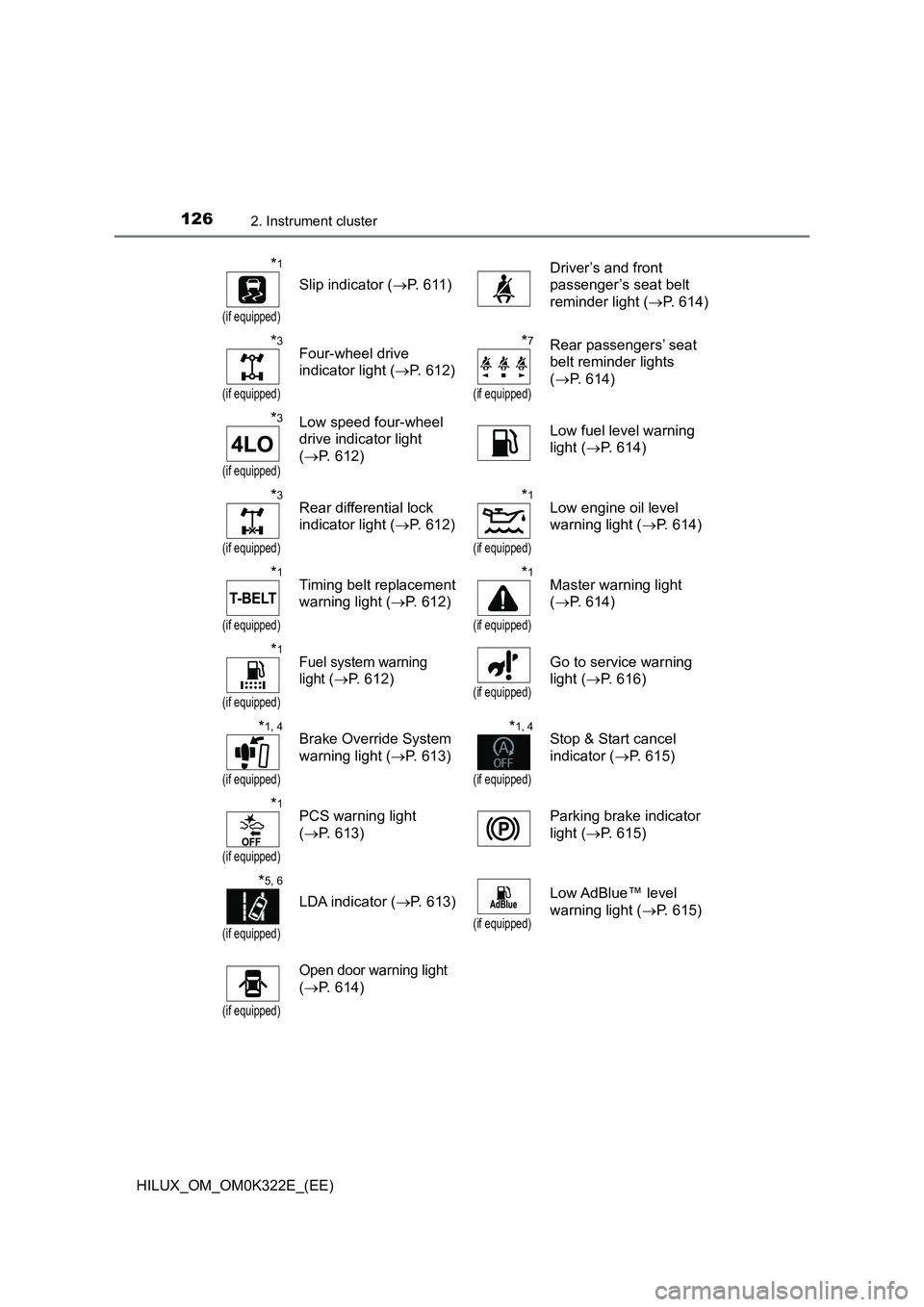
1262. Instrument cluster
HILUX_OM_OM0K322E_(EE)
*1
(if equipped)
Slip indicator (P. 611)
Driver’s and front
passenger’s seat belt
reminder light ( P. 614)
*3
(if equipped)
Four-wheel drive
indicator light ( P. 612)
*7
(if equipped)
Rear passengers’ seat
belt reminder lights
( P. 614)
*3
(if equipped)
Low speed four-wheel
drive indicator light
( P. 612)
Low fuel level warning
light ( P. 614)
*3
(if equipped)
Rear differential lock
indicator light ( P. 612)
*1
(if equipped)
Low engine oil level
warning light ( P. 614)
*1
(if equipped)
Timing belt replacement
warning light ( P. 612)
*1
(if equipped)
Master warning light
( P. 614)
*1
(if equipped)
Fuel system warning
light ( P. 612)(if equipped)
Go to service warning
light ( P. 616)
*1, 4
(if equipped)
Brake Override System
warning light ( P. 613)
*1, 4
(if equipped)
Stop & Start cancel
indicator ( P. 615)
*1
(if equipped)
PCS warning light
( P. 613)
Parking brake indicator
light ( P. 615)
*5, 6
(if equipped)
LDA indicator (P. 613)
(if equipped)
Low AdBlue™ level
warning light ( P. 615)
(if equipped)
Open door warning light
( P. 614)
Page 128 of 720
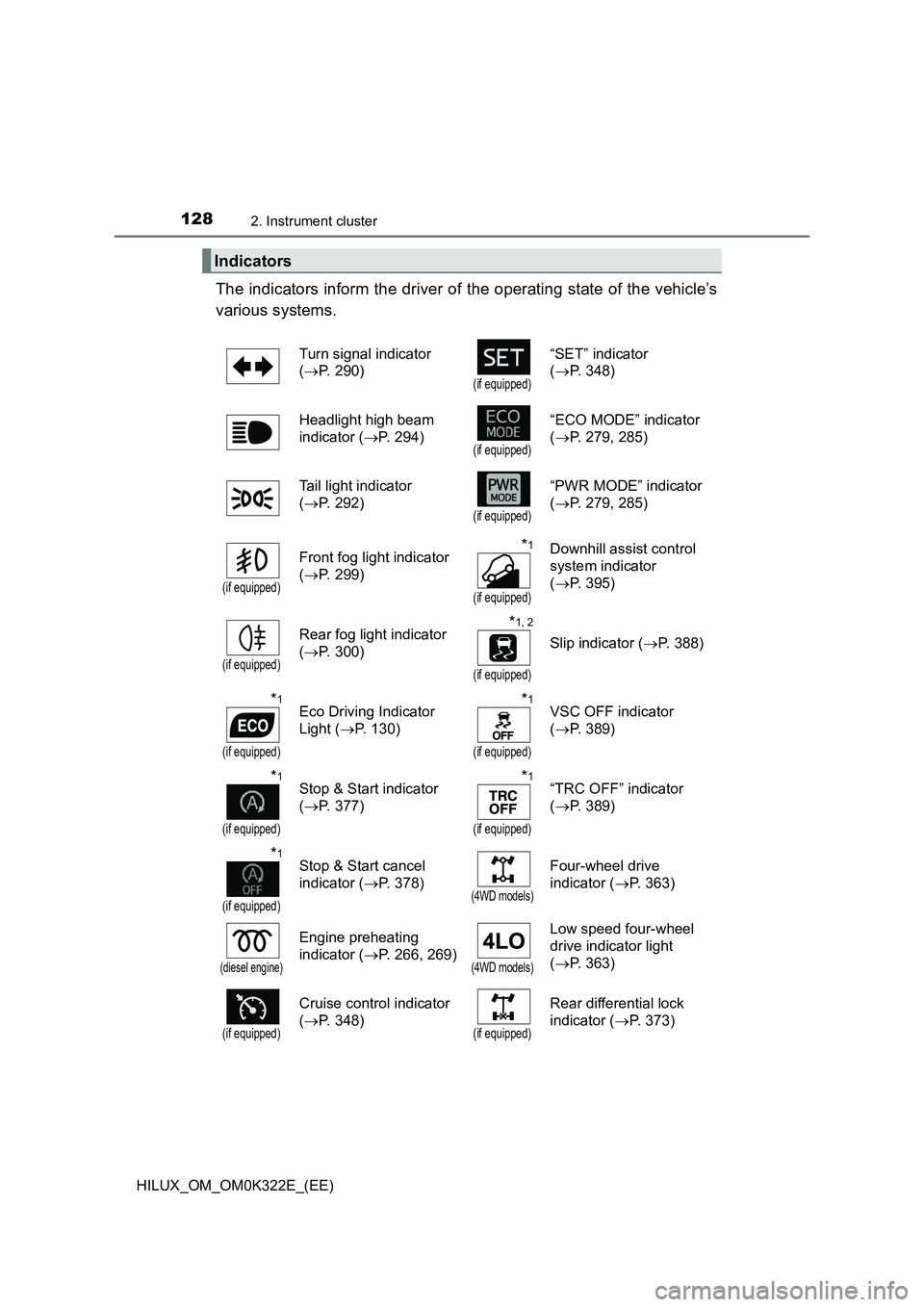
1282. Instrument cluster
HILUX_OM_OM0K322E_(EE)
The indicators inform the driver of the operating state of the vehicle’s
various systems.
Indicators
Turn signal indicator
( P. 290)(if equipped)
“SET” indicator
( P. 348)
Headlight high beam
indicator ( P. 294)(if equipped)
“ECO MODE” indicator
( P. 279, 285)
Tail light indicator
( P. 292)(if equipped)
“PWR MODE” indicator
( P. 279, 285)
(if equipped)
Front fog light indicator
( P. 299)
*1
(if equipped)
Downhill assist control
system indicator
( P. 395)
(if equipped)
Rear fog light indicator
( P. 300)
*1, 2
(if equipped)
Slip indicator (P. 388)
*1
(if equipped)
Eco Driving Indicator
Light ( P. 130)
*1
(if equipped)
VSC OFF indicator
( P. 389)
*1
(if equipped)
Stop & Start indicator
( P. 377)
*1
(if equipped)
“TRC OFF” indicator
( P. 389)
*1
(if equipped)
Stop & Start cancel
indicator ( P. 378)(4WD models)
Four-wheel drive
indicator ( P. 363)
(diesel engine)
Engine preheating
indicator ( P. 266, 269)(4WD models)
Low speed four-wheel
drive indicator light
( P. 363)
(if equipped)
Cruise control indicator
( P. 348)(if equipped)
Rear differential lock
indicator ( P. 373)